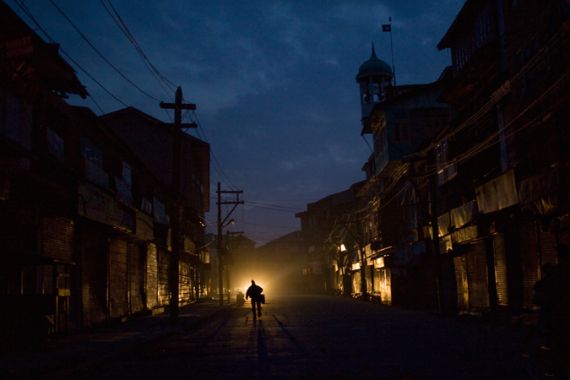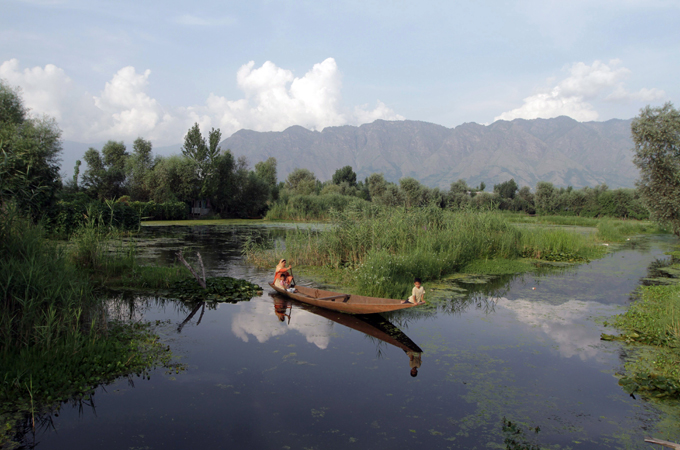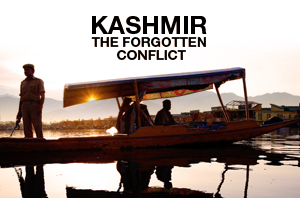Kashmir: Pakistan’s ‘unfinished agenda’
Jockeying over Kashmir has caused two wars and several warlike crises between India and Pakistan since 1947.

 |
| Growing water scarcity in Pakistan has meant that tensions over Kashmir currently revolve around the Indus basin [EPA] |
Islamabad defines Kashmir as a “core” issue and the “root cause” of tension with India. The dispute has caused two of the three major wars between the South Asian nations – and several warlike crises.
The traditional narrative that has dominated Pakistan’s Kashmir policy, since its independence in 1947, has different strands – involving differences over territory, ideology, right of self-determination, security, sovereignty and now, increasingly, water. Besides, it has always remained a highly emotive issue in the domestic politics of Pakistan.
The unfinished agenda
Kashmir is invariably described as an “unfinished agenda” of partition, a shahrug [“jugular vein”], and is considered integral to the Islamic identity of the Pakistani state. It is a source of strategically important rivers that play a critical role in the food and energy security of the country.
As per the logic of the partition, with Muslim majority areas going to Pakistan, the princely state of Jammu and Kashmir – then ruled by a Hindu maharaja – should have joined Pakistan. However, India forcibly occupied the state on the basis of an instrument of accession by the maharaja, Hari Singh. The legality of the maharaja’s claim was never accepted by Pakistan. At best it was considered “conditional” and “provisional”, subjected to ascertaining the will of the people. India never allowed Kashmiris to decide on the final status of Kashmir, however, so Kashmir continues to be “disputed territory”.
UN resolutions and the right to self-determination
The right to self-determination emerged as the bedrock of Pakistan’s principled stand on the Kashmir dispute. Pakistan strongly believes that the right of self-determination, in accordance with UN resolutions, is central to the solution of the Kashmir conflict. The UN resolutions in 1948-49 recognise this right and clearly stated that: “Future status of the state of J&K shall be determined in accordance with the will of the people … and through the democratic method of a free and impartial plebiscite”.
The resolutions were not implemented and the vote never took place. This drove Pakistan to adopt a variety of strategies, comprising bilateral dialogue, third party mediation and military means to change “on-the-ground” realities in Kashmir in its favour. Besides, Islamabad pledged moral, political, diplomatic – and at times material – support to the armed Kashmir resistance movement.
Dialogue, mediation and military strategies
As the UN discussions reached stalemate, Pakistan tried a bilateral dialogue on Kashmir. In 1962-1963, six rounds of foreign minister-level talks were held between Zulfikar Ali Bhutto and Swaran Singh but without any success. The dialogue took place against the backdrop of the 1962 Sino-Indian border war, which exposed Indian vulnerability to China and to concerted pressure from the US and Britain. India used the opportunity to engage Pakistan, deflecting these pressures, yet not to resolve the Kashmir dispute.
The failure of talks drove Islamabad to resort to covert military means, resulting in the unsuccessful “Operation Gibraltar”, which escalated into the 1965 India-Pakistan war. The Soviet-mediated Tashkent agreement in 1966 stressed peaceful means to settle disputes – but also did not resolve the Kashmir dispute, other than noting its existence. This disappointed Pakistan and it continued to raise the issue at international fora, urging implementation of UN resolutions.
The 1971 war was not triggered by Kashmir, but it did affect Pakistan’s position and strategy on the disputed region. Under the 1972 Simla Agreement, both countries agreed to settle their differences “through bilateral negotiations or by other peaceful means mutually agreed upon”. It was interpreted differently in both capitals. India interpreted it as Pakistan’s commitment to solve the issue bilaterally – while Pakistan maintained that it did not exclude other means – read international mediation – if bilateral dialogue failed to settle the issue.
Furthermore, the ceasefire line was converted into the Line of Control (LoC) – to be respected by both sides and not to be altered unilaterally. India, however, emboldened by victory, refused permission to UN military observers (UNMOGIP) to operate from its side and violated the LoC by capturing Chorbatla. It then intruded upon the Sichen glacier in 1984 and seized Qamar sector in 1988. Given the severe political and territorial blow to Pakistan in the 1971 war, Kashmir was put on the back burner and there was no bilateral dialogue on Kashmir – though Islamabad continued to raise it at the UN, the Organisation of Islamic Countries, and, later, within the Non- Aligned Movement platform.
Pakistan supports ‘azadi’
The 1989-90 uprising in Indian-controlled Kashmir put the region back on Pakistan’s foreign policy agenda. It also aroused passion in domestic politics, especially among the religious right wing political parties and groups. Pakistan stepped up its support for the Kashmiri resistance – fighting for azadi “freedom” – and gave military support to fighters in Kashmir. Meanwhile, Islamabad strongly condemned the deployment of a massive number of Indian troops in Kashmir, who were bolstered by draconian laws, enjoyed impunity from accountability and indulged in grave breaches of human rights. Pakistani officials described Indian actions in Kashmir as “state terrorism”.
From 1990 to 2003, Pakistan’s political and material support to Kashmiri, Afghan and Pakistan-based fighters in Indian-controlled Kashmir became an instrument of its Kashmir policy. The main objective was to internationalise Kashmir, draw in third party mediation and pressure India to enter into meaningful negotiations on Kashmir. This was also done to assuage domestic political sentiments that were enraged by repression against the Kashmiri people, a substantive number of whom streamed into Azad Jammu and Kashmir (AJK).
‘The most dangerous place on earth’
|
During this period, Pakistan – as a result of retaliatory nuclear tests against India in 1998 – became a nuclear power, and Kashmir became a nuclear flashpoint. Former US president Bill Clinton described it as the “most dangerous place on earth”. The nuclear issue sparked the 1999 Kargil crisis, bringing two nascent nuclear powers to the brink of war. In the Kargil crisis, Pakistan tried unsuccessfully to cut off Indian supplies to the Siachen glacier, forcing it to demilitarise the region and involve the international community to play a mediating role. In reality, Kargil damaged Pakistan’s Kashmir cause. Pakistan lost international sympathy. It was not only forced to withdraw troops but the act also gave sanctity to the LoC, which in India was interpreted as the LoC practically acquiring the status of an international border.
Pakistan’s Kashmir cause suffered a further major blow following the September 11 attacks, as the US unleashed its global war on terrorism. The international context to the US fight against extremism and Muslim fundamentalism heavily impinged on the Kashmiri struggle, as the world became more responsive to the Indian position that Kashmiri resistance was a “terrorist activity” driven by Islamic fundamentalists, sponsored by Pakistan. India managed to exploit world opinion in its favour – and insisted that Kashmir be included in the US campaign against terrorism.
Against this backdrop, Pakistan tried to draw a distinction between the “freedom struggle” and “terrorism” – and struggled hard to win the argument that the “war on terrorism” should not affect the legitimacy of Kashmiris’ fight for the right to self-determination.
In 2002, in his address at the UN General Assembly, President Musharraf stressed: “The just struggles of a people for self-determination and liberation from colonial or foreign occupation cannot be outlawed in the name of terrorism.” Islamabad argued that, in the guise of “counter-insurgency operations” New Delhi was perpetrating “state terrorism” in Kashmir – and that the root causes of terrorism should be addressed as part of the US-led international campaign.
However, following 9/11, Pakistan condemned acts of terrorism in Kashmir, such as the October 1, 2001, attack on the Kashmir state assembly in Srinagar; the December 13, 2001, attack on the Indian parliament and various attacks on the Hindu Pandits inside Indian-controlled Kashmir. In his speech on January 12, 2002, Musharraf defined parameters for the Kashmir struggle. He declared:
| “No organisation will be allowed to indulge in terrorism in the name of Kashmir … anyone found involved in any terrorist act would be dealt with sternly. Strict action will be taken against any Pakistani individual, group or organisation found involved in terrorism within or outside the country.” |
This was done to defuse the ongoing military standoff, and to assure India that Pakistan did not approve of any terrorist act in India.
Islamabad banned five extremist outfits, two of them – Lashkar-e-Taiba (LeT) and Jaish-e-Mohammad (JeM) – were accused by India of conducting terrorist activities in Kashmir and India. Drawing a balance, Musharraf kept the emotive discourse alive by saying that “Kashmir runs in our blood” and “we will never budge an inch from our principled stand on Kashmir”. Pakistan assured continued moral, political and diplomatic support to Kashmiris and kept urging the international community to play an active role in resolving the Kashmir dispute – for the sake of durable peace in the region.
Thaw in relations
The changed regional-international realities led to a flexibility and pragmatism in Pakistan’s Kashmir policy. This was reflected in Musharraf’s “out-of-the-box” proposals that he floated in 2003, 2004 and 2006. He offered to move away from the UN-mandated plebiscite and meet India “half-way”. This marked a seismic shift in Pakistan’s traditional policy on Kashmir, and showed its readiness to explore solutions that could be “acceptable to all parties”.
In October 2004, Musharraf suggested a three-phased solution along ethnic and geographic lines. This indicated that Pakistan was ready to move away from a solution based on religious-communal lines which India regarded as a threat to its unity and secular identity. In December 2005, he floated a four-point formula that envisaged soft borders, demilitarisation, self-governance and a joint mechanism for supervision of Kashmir. It was again close to the idea of the “soft borders” that India was looking at favourably.
The basic premise of Musharraf’s proposals was that the solution to Kashmir could not be found in the status quo, an insistence on a vote – or converting the LoC into a permanent border – but in a creative solution based on concessions by all sides, yet meeting the aspirations of the Kashmiris. This was in line with Indian Prime Minister Manmohan Singh’s oft-repeated assertions that there would be “no redrawing of the boundaries on communal lines”.
Islamabad took several steps to further the new ideas. It extended support to the moderate faction of the All Parties Hurriyat Conference (APHC), and distanced itself from the hardline faction led by Ali Shah Geelani. The “back-channel” diplomacy was used in arriving at a compromise on the issue of travelling documents, regarding the Srinagar-Muzaffarabad bus service. Back-channel negotiations also began discussing the four-point formula – which many observed was secretive, but made significant progress in developing areas of aspirational convergence. The LoC was thrown open for travel and trade and intra-Kashmir dialogue got underway – albeit in a non-structured and sporadic manner.
But Musharraf’s “out-of-the-box” initiative lost steam, due to the slow response of New Delhi to Islamabad’s flexibility. As a new political government came into power in 2008, the back-channel dialogue came to a halt. Zardari’s government has gradually reverted to Pakistan’s traditional stance – but continues to support cross-LoC interactions, which is very much in line with the vision of the Pakistan Peoples Party (PPP) for “soft LoC”.
In August 2008, President Zardari advocated a policy of “soft borders, so that the people of the two parts of Kashmir can meet, travel and do business” – but without compromising Pakistan’s traditional position on Kashmir. Zardari’s administration has pulled back its sponsorship of jihad in Kashmir, and has stated that it wants a solution through a tripartite dialogue that involves Kashmiris and “fulfills the aspirations of the Kashmiri people”.
Water wars
Water dominates the discourse. Since 2007, water has gained prominence within Pakistan’s stance on Kashmir. India is constructing an array of hydroprojects on the western rivers – Jehlum, Chanab and Sindh – that flow through Kashmir and were allocated to Pakistan under the 1960 Indus Waters Treaty. Islamabad strongly believes that Indian projects not only violate the technical parameters laid down in the treaty, but will have a cumulative impact on the flow of water to downstream Pakistan. Growing water scarcity in Pakistan and emerging climatic threats to water resources of the Indus basin are making water a core issue in Kashmir, and water is likely to dominate future dialogue with India.
Kashmir can become a bridge of peace if a viable solution is found that serves the interests of Pakistan, India and Kashmiris. There is no military solution to Kashmir. The struggle in Kashmir has become non-violent – but India is not yet ready to provide Kashmiris any relief, or to involve them in a tripartite dialogue process. Inclusion of Kashmiris is a necessity for a durable settlement in Kashmir. But if the conflict is settled, there is ample scope for the harnessing of the hydro-resources of Kashmir – which will benefit Pakistan, India and the Kashmiris themselves.
Dr Shaheen Akhtar is a senior research fellow at the Institute of Regional Studies in Islamabad.
The views expressed in this article are the author’s own and do not necessarily represent Al Jazeera’s editorial policy.

